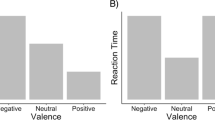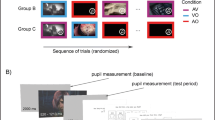Summary
Arousal during learning is known to be related to subsequent trend in retention. The purpose of this study was to determine whether the relation is the same for auditory and visual learning. Arousal during learning was measured by GSR recorded while high school students viewed an instructional film scheduled by the teacher as an integral part of the course. Retention trend was measured by 15 film-related (7 auditory, 8 visual) items administered immediately after the film and one week later. Intraindividual analysis indicated that the significant relations between arousal and retention trend were almost identical for auditory and visual information. Implications for the design of instructional films were discussed. An interpretation of the result from a similar study was offered.
Similar content being viewed by others
References
Baron Naomi. “Memory and Emotion.”American Psychologist 17: 146–48; 1962.
Becker, S. L. “Interest, Tension, and Retention.”AV Communication Review 12: 277–91; Fall 1964.
Berry, R. N. “Skin Conductance Levels and Verbal Recall.”Journal of Experimental Psychology 63: 275–77; 1962.
Kleinsmith, L. J., and Kaplan, S. “ Paired-Associate Learning as a Function of Arousal and Interpolated Interval.”Journal of Experimental Psychology 65: 190–93; 1963.
Levonian, E.Measurement and Analysis of Physiological Response to Film. Final Report, Grant No. 704094. Washington, D.C.: U. S. Office of Education, 1962.
—-. “Skin Resistance Electrode for Classroom Use.”Psychological Reports 13: 451–60; 1963.
—. “ Retention of Information in Relation to Arousal During Continuously-Presented Material.”American Educational Research Journal 4:103–16; 1967.
-Levonian, E.“Short-Term Retention in Relation to Arousal.”Psychophysiology, Vol. 4; January 1968 (in press).
Maltzman, L; Kantor, W.; and Langdon, B. “Immediate and Delayed Retention, Arousal, and the Orienting and Defensive Reflexes.”Psychonomic Science 6: 445–46; 1966.
McGaugh, J. L. “Time-Dependent Processes in Memory Storage.”Science 153: 1351–58; 1966.
Rosenstein, A. J. “ Psychometric versus Physiological Anxiety and Serial Learning.”Journal of Personality 28: 279–92; 1960.
Turner, R. H., and Barlow, J. H. “Memory for Pleasant and Unpleasant Experiences: Some Methodological Considerations.”Journal of Experimental Psychology 42: 189–96; 1951.
Walker, E. L, and Tarte, R. D. “Memory Storage as a Function of Arousal and Time with Homogeneous and Heterogeneous Lists.“Journal of Verbal Learning and Verbal Behavior 2: 113–19; 1963.
Author information
Authors and Affiliations
Additional information
This study was funded by the California Transportation Agency and the Bureau of Public Roads, Federal Highway Administration, U. S. Department of Transportation. The measurement and analysis techniques were developed under a grant by the U. S. Office of Education. Data collection was facilitated by the cooperation of Robert Lewis, Jack Moscowitz, Gerwin C. Neher, Eugene Olson, Herbert Popenoe, Melvin T. Schroeder, and George L. Wilson, all of the Los Angeles City School System. Data analysis was performed at the UCLA Computing Facility.
Rights and permissions
About this article
Cite this article
Levonian, E. Auditory and visual retention in relation to arousal. AVCR 16, 57–62 (1968). https://doi.org/10.1007/BF02768681
Issue Date:
DOI: https://doi.org/10.1007/BF02768681




